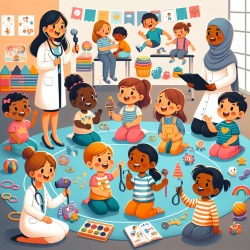Introduction
In the field of speech-language pathology, understanding the diverse backgrounds of the children we serve is crucial for providing effective and culturally sensitive care. Recent research, such as the study titled "The Voices of Interracial and Interethnic Couples Raising Biracial, Multiracial, and Bi-ethnic Children Under 10 Years Old," offers valuable insights into the unique experiences of multiracial families. This blog explores how practitioners can apply these findings to enhance their practice and improve outcomes for multiracial children.
Key Findings from the Research
The study conducted qualitative interviews with 19 parents in interracial and interethnic marriages raising children under the age of 10. Four main themes emerged from the research:
- Racism/Discrimination: Parents expressed concerns about their children's experiences with racial discrimination and microaggressions, both presently and in the future.
- Ethnic-Racial Identity Development: Parents discussed the importance of facilitating their children's understanding of their diverse backgrounds through media, family interactions, and cultural exposure.
- Skin Color: Discussions about skin color were prevalent, with parents noting the societal implications of their children's racial presentation.
- Benefits of Being Multiracial: Parents highlighted the advantages of having a multicultural background, such as increased empathy and open-mindedness.
Implications for Speech-Language Pathologists
As speech-language pathologists, it is essential to integrate cultural humility into our practice. Here are some actionable steps practitioners can take based on the study's findings:
- Addressing Racism and Microaggressions: Create a safe space for families to discuss experiences of racism and microaggressions. Encourage open dialogue and provide support in developing strategies to address these issues.
- Supporting Ethnic-Racial Identity Development: Incorporate culturally relevant materials and activities into therapy sessions. Encourage families to share their cultural traditions and languages to enrich the child's learning experience.
- Understanding Skin Color Dynamics: Be aware of the societal perceptions related to skin color and how they may impact the child's self-esteem and identity. Foster a positive self-image by celebrating diversity in all its forms.
- Highlighting Multicultural Benefits: Emphasize the strengths and advantages of being multiracial. Use these as a foundation for building resilience and fostering a positive outlook in children.
Encouraging Further Research
While this study provides valuable insights, there is a need for further research to explore the experiences of multiracial families across different contexts and regions. Practitioners are encouraged to stay informed about ongoing research and contribute to the body of knowledge by sharing their observations and experiences.
Conclusion
By integrating the findings from this research into our practice, speech-language pathologists can better support multiracial children and their families. Embracing cultural humility and understanding the unique challenges and strengths of these families will lead to more effective and meaningful interventions.
To read the original research paper, please follow this link: The Voices of Interracial and Interethnic Couples Raising Biracial, Multiracial, and Bi-ethnic Children Under 10 Years Old.










